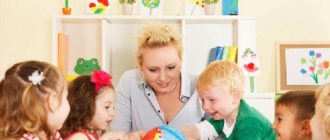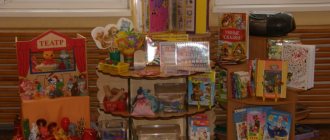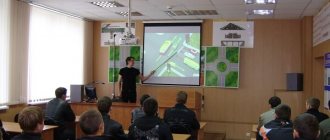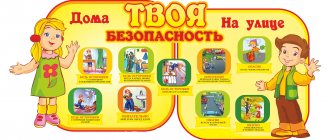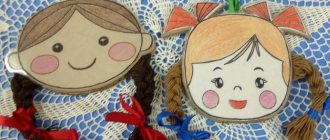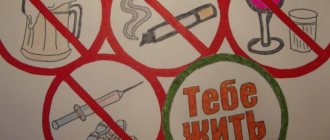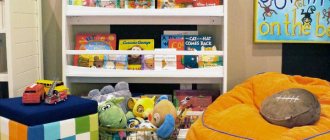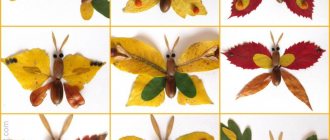The design of group rooms in preschool institutions plays an important role in the development of the child; thanks to a rationally prepared environment, the educational process is more effective, and the full cognitive, physical and social development of the child becomes possible. Of great importance in solving the problems of each of the areas is the children's corner, in which didactic materials, manuals, fiction and methodological literature are located, and for older children it is recommended to design a children's school corner.
Selecting a location and main requirements
Corners in kindergarten are usually located according to thematic zones: physical education, book, creative, patriotic, and so on. In each age group, the appropriate arrangement of furniture and wall materials for each zone is thought out in accordance with the age of the children. The design of corners in kindergarten in each group must meet a number of general requirements. First of all, this is safety .
Our safety
This requirement implies that furniture, stands and visual aids located in the safety zone must be made of high-quality, environmentally friendly materials. Also, the safety of the design of this area includes: the stability of the furniture, well-fixed shelves and racks, the absence of sharp corners and chips.
The second requirement is accessibility. This area should be located in a place free for children to access, be clearly visible, and correspond to the height of the children. Safety zone materials must take into account the gender, age and individual capabilities of children.
The third requirement is aesthetic design. It is ensured through the beautiful design of stands, shelves, and the demonstration and teaching materials themselves. There should be no torn books or broken toys in this area. It is better to choose bright, saturated colors for decoration, but at the same time compatible with each other.
Another requirement is flexibility. It assumes the possibility of periodically updating materials in the security zone, introducing new details, interesting books, toys, and visual aids into its design.
A separate information stand “Safety Corner in Kindergarten” is set up in the preschool institution. Most often, it is located in the lobby so that parents of students can get acquainted with up-to-date and competent information at any time. Materials for the stand are developed jointly with employees of the State Traffic Inspectorate.
Crafts from salt dough for February 23
Today, the souvenir departments offer a large selection of products made in the relevant theme. Do-it-yourself military-patriotic crafts help to instill an understanding of the Great Patriotic War, military battles and enormous losses.
Professional teachers recommend choosing handicraft techniques that are based on fine motor skills. For example, the sculpting process helps activate the imagination of toddlers and preschoolers.
What can you choose for a patriotic craft for school? We propose to make a miniature picture from salt dough, in which a soldier and military equipment will be present.
For the creative process you will need:
- Salty dough;
- Set of acrylic paints;
- Set of brushes;
- Hot melt adhesive;
- Small plywood;
- Frame;
- Glitter.
Progress:
- It is necessary to sculpt the head, arms, legs, and torso of the future soldier from salt dough. The thickness of each part should be no more than 1 cm. Thanks to this, the fake can be fixed in a vertical position. All elements must dry on their own within 3 hours. In the process of sculpting in the face area, it is necessary to form the eyes, nose and mouth.
- Using acrylic paints, we paint all the details in accordance with the sketch. To make the product realistic you will need to use brushes. We paint the soldier's body in a beige shade. His clothes will combine several colors. The child must independently paint the uniform dark green. For camouflage spots you will need to use black and brown tones.
- When all the parts are ready, you need to glue them to the surface of the plywood with a heat gun. The background can be decorated with dense plantings of trees, grass and flowers. The child can independently design small elements in a military composition.
- Let's move on to making the tank. It is also made from salt dough. The first step is to make a powerful body of the combat vehicle. To do this, a small element of plastic mass is turned into a trapezoid. Wheels are made from small balls. The tower is made of a compact oval, and the barrel is made of a miniature square. All parts must dry well so that cracks do not appear on their surface. After which you can paint them with acrylic paints.
- For work, dark green, brown and black shades of dye are used. After this, we glue the elements onto the plywood. Use a hot-melt gun to make smooth lines, which we sprinkle with bright glitters. As a result, we get a festive fireworks display. The final step will be to use a photo frame. This creates a beautiful panel dedicated to the holiday of February 23 and May 9.
Purposes of creation and main patriotic attributes
Fostering patriotic feelings is one of the areas of work of preschool educational institutions with the younger generation - especially relevant in modern conditions, when numerous changes are taking place in the life of society. For the successful implementation of the system of patriotic education of children in a preschool institution, the development of their cognitive interest and activity, it is necessary to create a competent subject-development environment.
Basic Attributes
A patriotic corner in kindergarten helps teachers introduce children to: the history and sights of their native land, animals and plants, transport; with state symbols of the native country and city (flag, coat of arms, anthem, portraits of the president and head of the city); with Russian folk crafts and traditions of other peoples. Thanks to the materials in such a zone, children develop interest and respect for their family and their preschool institution, the work of people of different professions, and the achievements of famous people of the city and country.
Proper design of a patriotic corner in a kindergarten will allow each child to be involved in the study, help to select material based on strengths and interests, and also establish joint work with the teacher and peers. The materials in the corner should reflect the main directions of pedagogical work on the education of patriotism: “Family”, “Native land”, “Folk crafts”, “Acquaintance with the work of adults”, “Cultivating love and respect for the defenders of the Fatherland”, “Moscow is the capital of our Motherland” "
Main attributes
Mandatory attributes for a patriotic corner are: the anthem, the Russian flag, a portrait of the president and the coat of arms of Russia. The anthem is a solemn musical and poetic work, a symbol of our state. Usually it is issued in text form and is located on the stand. However, there must be a musical version in the corner for children to listen to. The flag of the Russian Federation is a rectangular canvas of three colors: white, blue, red (from top to bottom). White color means peace, purity; blue is a symbol of faith and constancy; red – energy, strength and blood shed for the Motherland. In the corner, the flag can be presented in different versions, as a large canvas on the wall or standing on a pole, or as a small flag on a special stand.
The coat of arms of Russia is another state symbol, a quadrangular shield with the image of a golden crowned double-headed eagle with an orb and a scepter in its paws. On the chest of an eagle in a red shield there are images of St. George the Victorious slaying a serpent. The portrait of the country's president is also placed on a stand with state symbols, mainly in the center or on the left.
To accustom your pupils to cleanliness and order, make a duty corner in kindergarten with your own hands. The children themselves can decorate the playground. Find out how to organize a craft competition in this article.
Do you want to create a beautiful playground for children? Then the article at https://karuselkin.ru/detskaya-ploshhadka/stroitelstvo-detskoj-ploshhadki-svoimi-rukami/ link will help you.
Options for a children's patriotic corner in kindergarten
Options for corners
The arrangement of objects and the organization of the patriotic corner can have several options depending on the age of the students. Patriotic corners in kindergarten for younger groups can be represented mainly by materials on getting to know the immediate environment. These are, first of all: folders, didactic games, illustrations on the topics “Adults”, “Family”, “The House You Live In”, “Child and His Peers”, “Emotions”, “Rules of Conduct in Public Places”. Also in the corner there are: models and photographs of a group, a preschool institution, a street; antiques, Russian folk toys, fiction for children.
material about family holidays and traditions is added to the territory of the middle group . In addition to the layout of the street and preschool educational institution, albums, postcards with the sights of the native city/village, famous citizens, representatives of the animal and plant world, transport, and architecture are added. In the middle group, elements of state and municipal symbols (flag and coat of arms), as well as folders with illustrations on the theme “Defenders of the Fatherland,” appear in the design of the corner. It would be advisable to set up a “Traffic Regulations Corner in Kindergarten” next to materials about the transport of your native land. This will allow us to approach solving educational problems in a comprehensive manner.
In older groups, corners can be represented by family photo albums, homemade books on the topics “Coat of Arms of My Family”, “Family Tree”. Thematic folders with illustrations about the history of the native land, industry, attractions, culture and education, and so on. In the corner there are all the symbols of the state and native land (anthem, flag, coat of arms, portraits of the president of the country, mayor of the city); maps of the Russian Federation and the region, adapted for children. Material about Orthodoxy is introduced.
It is also advisable to place a traffic rules corner in a kindergarten for older preschoolers close to the patriotic corner. It includes children's drawings on road safety, individual illustrations or photographs with types of traffic lights and crossings, and traffic signs. This may include photographs from the streets of your hometown.
Thus, when designing a patriotic corner in a preschool group, the main thing is to take into account the age-related capabilities of children and the tasks that must be solved at this age. We should also not forget about the mandatory safety, accessibility and aesthetics of materials.
Recommendations for the design of patriotic and local history corners in different age groups of preschool educational institutions
Natalya Izbasarova
Recommendations for the design of patriotic and local history corners in different age groups of preschool educational institutions
When implementing an educational program for preschool education in various organizational models and forms, a developing subject-spatial environment (hereinafter referred to as RPES)
must provide:
• compliance with the general education program of the preschool educational institution;
• compliance with the age capabilities of children ;
• transformability depending on the educational situation, interests and capabilities of children;
• the ability to use various toys, equipment and other materials in different types of children's activities;
• variable use of various spaces (premises)
and materials
(toys, equipment, etc.)
to stimulate children's development;
• availability of free access for children directly in the organized space to toys, materials, aids and technical means of the environment.
• compliance of all components of the RPPS with safety and reliability requirements when used in accordance with current SanPiN.
Taking into account the above requirements, the preschool educational institution must ensure variability at the content-pedagogical level of the educational process. This problem is solved systematically, arranging the set of play facilities of preschool educational institutions into a “system of play facilities”
–
"game support for children's development"
.
A subject-based developmental environment for patriotic education promotes the development of speech, imagination, thinking, broadens horizons, promotes the moral development of the child’s personality, and fosters love for his hometown, his native land, Russia.
Goal: creating conditions conducive to instilling patriotism in children , pride in their native land and love for the Motherland.
Objectives of educational activities in the corner of local history :
• teach the child to understand that both people and things have their own history;
• awaken in young citizens a feeling of love for their city, region, country, respect for traditions and customs;
• cultivate a tolerant attitude towards other nations and people of different nationalities; respect for the culture of other peoples (customs, traditions, willingness to understand and accept a system of other values;
• to form the spiritual and moral attitude of the child to the family, country, nature of the native land, the unity of aesthetic feelings and moral values;
• awaken emotional responsiveness in children through exposure to art, music, literature, and folk culture;
• develop the need for independent exploration of the surrounding world by studying the cultural heritage of different eras and peoples ;
• to develop a preschooler's sense of self-esteem.
Design requirements :
• aesthetic orientation;
• rational placement of a corner on local history ;
• taking into account the age characteristics of children ;
• educational and developmental orientation;
• the feasibility of placing “exhibits”, accessibility, scientific character, reliability of the presented material;
• Safety.
An indispensable condition for building a developmental environment in preschool institutions is reliance on a personality-oriented model of interaction between people.
Principles:
- the first principle of openness to Nature, promoting the unity of man and Nature.
- the second principle of openness to Culture, i.e. elements of real painting, literature, music. Familiarity with specific regional cultures, arts and crafts with folklore elements, this will undoubtedly contribute to the education of patriotism in children , pride in their places, and the formation of ideas about the “small Motherland”
and feelings of love for her.
— the third principle of openness to society. Parents have a special right to participate in the life of the kindergarten.
— the fourth principle is openness of one’s “I”
, your own inner world.
The environment is organized in such a way as to contribute to the formation and development of the image of “I”
.
the fifth principle of taking into account gender and age differences in children . The environment must be designed so that both boys and girls can express their inclinations in accordance with the standards of masculinity and femininity accepted in society.
REQUIREMENTS FOR PATRIOTIC CORNERS AND CORNERS OF LOCAL STUDIES BY GROUPS
Junior group .
The main goal of patriotic education is familiarization with the immediate environment. Children are instilled with a feeling of love and care towards their family and other people, children’s ideas about kindergarten, about the work of preschool workers, about their small homeland (city) are formed, involvement in modern events is formed, initial ideas about national cultural traditions, about national and state holidays; about the nature of the native land; about objects of decorative and applied art.
Therefore, in the corner there should be :
1. Material for work on social and moral education:
— thematic folders with illustrations, didactic games on the topic “Adults”
(generic characteristics, professions, actions, appearance)
;
- thematic folders with illustrations on the topic “Family”
(family members, joint activities, family photos)
- photographs, illustrations on the topic “The House Where You Live”
(architectural structures that differ in size, appearance, building material, purpose);
— thematic folders with illustrations on the topic “Child and his peers”
(girls and boys, games, children in
different situations , activities, etc.);
— thematic folders with illustrations, pictograms showing the different emotional states of adults and children;
- thematic folders with illustrations, didactic games, books telling about the rules of behavior in public places, etiquette (like “you can do this, but you can’t do that”
).
2. Material for introducing children to their small homeland: ( group , kindergarten, street or neighborhood where the preschool educational institution is located, thematic folders with photographs and illustrations of the village, postcards, albums.
3. Material on introducing children to the origins of Russian folk culture: antiques, Russian toys; dolls made from wooden logs, amulets, objects of folk arts and crafts (matryoshka dolls, Dymkovo toys, various types of painting, embroidery, wood carving, etc.); dolls in national costumes.
4. Fiction (songs, nursery rhymes, fairy tales, etc.)
.
Sample material:
•Albums: “My Family”
,
“Our kindergarten”
,
“My native village”
;
• Pedigree trees of children;
• Illustrations depicting animals of our forests, nature at different times of the year , trees, flowers characteristic of the Bryansk region;
• Dolls (boy and girl)
in national costume;
• Items of decorative and applied art
• Books, albums with Russian folk tales, nursery rhymes, jokes;
• Illustrations, photographs depicting national and state holidays. Thematic illustrations of military equipment for March 8, February 23, May 9.
Middle group .
Work is carried out in the following areas: “My family”
,
“My kindergarten”
,
“My village and its attractions”
,
“Famous fellow countrymen”
,
“Introduction to the origins of Russian culture”
. Pupils develop an interest in national and universal values, cultural traditions of the people; about the village; about the national flag, coat of arms; about folk heroes; Russian holidays; about the nature of the native land; about objects of decorative and applied art; about modern architecture.
1. Material on social and moral education is being replenished: family holidays and traditions, fiction on relevant topics (see requirements for the design of a corner in younger groups ).
2. Material for introducing children to their small homeland: ( group , kindergarten, street or neighborhood where the preschool educational institution is located, thematic folders with photographs and illustrations, postcards, albums dedicated to the sights of the village and its famous residents, flora and fauna, transport, architecture , professions of residents. Materials about the history of the village can be presented.
3. Material for introducing children to the origins of folk culture: antiques, folk toys; dolls made from wooden logs, amulets, objects of folk arts and crafts (matryoshka dolls, Dymkovo toys, various types of painting, embroidery, wood carving, etc.); various layouts (peasant hut, upper room, peasant farmstead, etc.)
; dolls in national costumes; didactic games.
4. Fiction (fairy tales, songs, proverbs, sayings, etc.)
.
5. Elements of state symbols of the Russian Federation (flag, coat of arms)
.
6. Elements of regional symbols (flag, coat of arms)
.
7. Elements of municipal symbols (coat of arms, village flag, logos of industrial enterprises)
.
8. Material dedicated to the defenders of the Fatherland: thematic folders with illustrations.
In the middle group in the corner there should be :
• State symbols (flag, coat of arms, anthem text)
• Portrait of the President
•Albums: “My Family”
,
“Our kindergarten”
,
“My native village”
,
• Pedigree trees of children;
• Illustrations depicting animals in our forests, nature at different times of the year , trees, flowers characteristic of the region;
• Dolls (boy and girl)
in national costume;
• Items of decorative and applied art);
• Illustrations depicting architectural monuments, modern buildings of the native village;
• Books, albums with Russian folk tales, nursery rhymes, jokes;
• Illustrations, photographs depicting national and state holidays.
• Crafts from waste and natural materials, made by the hands of children and adults
Senior and preparatory school groups .
The main areas of work are local history , familiarization with the native country, state symbols, the historical past of Russia, organizing the lives of children according to the national calendar. They form pupils’ ideas about family and pedigree; about your kindergarten. They introduce you to the sights of the village, the capital, and history. With the geographical location of the country, which states it borders with. About the capital of our Motherland. They talk about the flag and coat of arms about the history of the country, about the heroic past of our Motherland. They continue to introduce state and national holidays, works of folklore, works of Russian writers, etc. They form ideas about objects of decorative and applied art; about modern architecture.
1. My family - family photo albums, homemade books on the topic
"My family's coat of arms"
,
"Family tree"
.
2. Thematic folders with illustrations and photographs: “The history of the village”
,
“Industry of the village”
,
“Science, education and culture of Russia”
,
“Famous fellow countrymen”
,
“Bryansk region during the Great Patriotic War”
,
“Sights of the Klimovsky district”
,
“Architecture”
,
“Sports”
.
A selection of poems about the village, the region . Map of the region, village. Symbols (flag, coat of arms, anthem)
.
Layouts (neighborhood, street, architectural structures of the village)
.
3. Thematic folder “My Land”
: map and symbols of the Bryansk region, portrait of the Head of the region;
material introducing children to the glorious past of their native land (the history of cities and their present, agriculture)
.
4. Home country - map of the Russian Federation. It is desirable that this map be intended for children and contain the necessary material about the cities of Russia (the capital of the Motherland, symbols of cities, main attractions)
;
about natural areas; about the peoples inhabiting the country; about industry and agriculture. Symbols of Russia (coat of arms, flag, anthem)
.
Portrait of the country's president. Various layouts (city attractions, architecture, etc.)
.
Defenders of the Fatherland - illustrations, thematic folders on the topic: “Our ancestors are the Slavs”
,
“Bogatyrs of the Russian Land”
,
“Great Patriotic War”
,
“War of 1812”
,
“Russian Army”
.
Photo material “Monuments of military glory”
.
Fiction and didactic games on the topic, models (ancient fortress, military equipment, etc.)
. Introduction to the origins of Russian folk culture - illustrations and
thematic folders on the topics “How people lived in Russia”
,
"Antiques"
,
“From the history of Russian folk costume”
,
“Folk holidays and festivities”
,
“Folk calendar”
; antiques, Russian toys, folk arts and crafts, various models, dolls in national costumes, didactic games on the topic.
5. Spiritual and moral education - material that gives children an initial idea of Orthodoxy (this could be a selection of illustrations depicting churches and their architectural features, a selection of postcards on the theme “Russian icon”
, model of the temple, children's Bible).
6. Our planet Earth - globe, children's world map. Artistic
literature, illustrations, thematic folders telling about the lives of people in other countries of the world, their customs, traditions, professions characteristic of a particular country.
7. Fiction on folklore (fairy tales, epics, legends)
. Great compatriots - portraits, fiction,
telling about the great compatriots who glorified Russia, the Bryansk and Klimov lands, and their portraits.
In the senior and preparatory groups the following are added to the patriotic corner :
• State symbols (flag, coat of arms, anthem text)
• Portrait of the President
• Country map, globe
• Dolls in national costumes
• Albums with architectural monuments of the country.
•Albums: “My City”
,
"Our great compatriots"
.
These are writers, poets, artists, etc., “Victory Day”
• Items of decorative and applied art;
• Illustrations depicting architectural monuments, modern buildings of the native village;
• Books, albums with Russian folk tales, nursery rhymes, jokes;
• Illustrations, photographs depicting national and state holidays.
• Various educational and fiction literature;
•Albums: “My Family”
,
“Our kindergarten”
,
“My native village”
,
“Cities of heroes”
;
• Illustrations depicting animals in our forests, nature at different times of the year , trees, flowers characteristic of our nature;
• Pedigree trees of children;
• "Our army is dear"
, thematic albums of military branches and military equipment.
• Collection of thematic icons (about the city, about the war, about the army, etc.)
• Sets of postcards “Russian life”
.
• Cassettes with recordings of fairy tales and patriotic songs . Audio and video tapes about the nature of the native land.
• Crafts from waste and natural materials, made by the hands of children and adults.
• Costume area (caps, caps, caps, capes, raincoats, collars, belts, binoculars, long skirts, scarves, shawls).
The tasks of moral and patriotic education are implemented not only through the content of the local history corner , but also through the content of other areas of independent children's activity:
— in corner, samples of decorative and applied creativity are presented;
— in corner there are thematic sets for role-playing games: “Barbershop”
,
"Hospital"
,
"Shop"
. These games help enrich children's ideas about professions.
— in corner there are attributes for Russian folk outdoor games.
— Russian folk tales, epics, small folklore forms (nursery rhymes, lullabies, etc.) are placed a corner thematic exhibitions of literature are organized
Thus, not only the local history corner , but also the entire subject-development environment of the group room is aimed at solving the problems of moral and patriotic education of preschool children .
Literature
1. Aleshina N.V. Introducing preschoolers to their hometown. - M.: TC Sfera, 1999. - 112 p.
2. Aleshina N.V. Patriotic education of preschool children. - M.: TsGL, 2004. - 156 p.
3. Vasiltsova Z.I. Wise commandments of folk pedagogy. - M.: Pedagogy, 1983.
4. Kondrykinskaya L. A. Where does the Motherland begin. — M. T. Ts. Sphere 2005
5. Korotovskikh N. Methodological support of local history in preschool educational institutions . /N. Korotkovskikh / Preschool Education Management //2006.- No. 8.
6. Komratova N. G., Gribova L. F. My small homeland. /N. G. Komratova /Management of preschool educational institution// 2005. No. 1.
7. Rybakov I. Familiarization with one’s hometown as a means of patriotic education /I . Rybakov /Preschool education// 2003. No.
